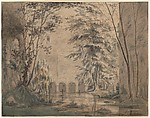Inundated Ruins of a Monastery
Karl Blechen German
Not on view
With Caspar David Friedrich and Johan Christian Clausen Dahl, who both exerted a major influence on his art, Karl Blechen can be termed one of the leading landscapists of German Romanticism. A more overtly subjective painter, he transformed his observations of nature and architecture by means of his imagination and technical experiments. The proud medieval building in this drawing—in fact hardly more than a seemingly endless wall supported by a row of arched vaults—has been overgrown by vegetation and worn away by water. The quintessentially Romantic theme of the victory of nature over man is animated by the richness of Blechen's technique: he scraped away ink to add highlights to the water and evoke the scaly surface of the stems of the trees at left. The drawing is directly related to a painting from 1824 that was unfortunately destroyed in a fire in 1931. Its nervous yet careful execution and the differences between it and the painting, in which the inundated wall is seen from within a cavern, suggest that it was intended as an independent work, an inspired repetition on paper of a celebrated canvas. The absence of the arch of the cavern in the foreground places less emphasis on the imaginary character of the subject, making the drawing all the more haunting.
Due to rights restrictions, this image cannot be enlarged, viewed at full screen, or downloaded.



